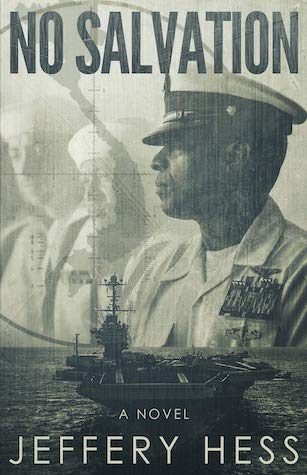The Facts and Fictions of No Salvation by Jeffery Hess
 The Facts and Fictions of No Salvation
The Facts and Fictions of No Salvation
Imagine a handsome black man in the dress white uniform of a Navy officer—a decorated pilot, no less—driving around Newport, Rhode Island in the summertime, in a convertible with the top down. Commander Robert Porter is six-feet-two, recently turned forty, never married, though he’s dating a white woman.
Now imagine it’s 1972.
He could’ve enjoyed that lifestyle for two more years, but he gave it up the day he was offered the Executive Officer position aboard the USS Salvation. The ship was in the same South China Sea waters off the coast of Vietnam as it was when he’d flown from and to its flight deck hundreds of times earlier in the war. He never thought he’d have to return, but this second-in-command position was the next step toward his ultimate goal of being captain of his own carrier someday. He jumped on the opportunity.
Of course, his experience back aboard that ship isn’t as idyllic as was shore duty in Newport. Not only does he find a ship on the sixth month of an indefinite deployment, it is filled with racial tension and animosity. He also finds a racist captain who might’ve brought Porter on not for his leadership abilities, but only because of the color of his skin.
Rampant drug usage aboard ship is supplied by an illicit drug ring Porter is tasked with investigating and taking down. He doesn’t know in the beginning that some of the senior enlisted crew members assigned to help him are pulling the strings.
Meanwhile, a conscientious objector who turns to sabotage in his effort to impress a girl back home who wants him to stop planes from killing babies, wreaks havoc of his own.
Eventually, the captain’s demeaning policies increasingly anger the outnumbered black crew until they grow so agitated they damage the ship and improvise weapons from dogging wrenches, firefighting nozzles, and aircraft tie-down chains and go on the attack. No white crew member is safe and many pay the price.
Porter is personally and professionally on the hook to end the violence and save as much of the crew as possible—black and white.
 He tackles the challenge as instinctually as he flew planes above those dangerous waters a handful of years ago. He faces not only the unaccepting and outraged black crew, but also his own questions of who he was supposed to be and who he was meant to be.
He tackles the challenge as instinctually as he flew planes above those dangerous waters a handful of years ago. He faces not only the unaccepting and outraged black crew, but also his own questions of who he was supposed to be and who he was meant to be.
Of course, I didn’t set out to write this book, not at first anyway. And I didn’t do so in any way as to be completely factual, but it was inspired by actual events.
Back in 2014, I was writing short stories about the Cold War Navy and in my research, I happened across a New York Times article from November 26, 1972 that began:
“SAN DIEGO, Nov. 25—A House Armed Services subcommittee, winding up four days of inquiry here into the racial troubles aboard the aircraft carrier Constellation, recessed its hearing today and decided to return here Dec. 5 to investigate a mid‐October riot aboard the carrier Kitty Hawk.”
I read the rest of that article and about a dozen others before going so deep down the rabbit hole, I consumed all the non-fiction books I could find that detailed that period. I even read the US Congressional Report that came out of that subcommittee’s meetings.
Ordinarily, US Congressional Reports wouldn’t be my favorite thing to read, but I happened to find this section that stated, “Recent instances of sabotage, riot, willful disobedience of orders, and contempt for authority, instances which have occurred with increased frequency, are clear-cut symptoms of a dangerous deterioration of discipline.” Needless to say, I was in. And for the record, there’s probably not a better summary for the book than that.
That “dangerous deterioration of discipline” fascinated me and found its way into every aspect of this book. Those concepts are what made it so fun to write. I got to go back forty-seven years in history and create characters in dire situations and record their actions and reactions. Finding a protagonist as diverse and compelling as Porter is difficult. To have one come to me in various fashions was a gift.
I’ve been asked before and I never hesitate to say, I took no sides while writing this book. I wanted to convey the tensions and responses as I imagined them to unfold and leave judgment to the reader.
I’ve also been asked a few times about any apprehension I might’ve had writing across racial lines. The questions initially surprised me. I’d never considered it an issue. People are people, after all. And as Commander Porter declares, “All our bones are the same color.” As a writer, I am pro-realism and anti-censorship. My job as a novelist is to entertain and to aspire to what the great Tim O’Brien calls “the emotional truth.” Sure, I try to be as accurate as I can—in service to the story—but my job is not to construct an exact replica of anything. If I wanted to be a journalist, I would’ve accepted the job the, now defunct, Tampa Tribune offered me back in 1994.
Instead, I write novels that hopefully give a fuller depiction of what transpired.












